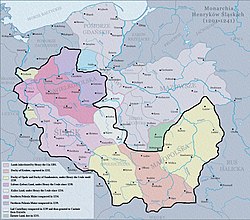Henry II the Pious
This article needs additional citations for verification. (September 2011) |
| Henry II the Pious | |
|---|---|
Hedwig of Andechs[2] |
Henry II the Pious (
Early life
Henry the Pious was the second son of High Duke
allowed Henry the Pious to participate actively in international politics.Henry the Bearded quickly designated his sole surviving son as his sole heir, and from 1222, the young prince countersigned documents with his father. By 1224, he had his own seal and notary. In 1227, during a meeting of Piast dukes in Gąsawa, Henry the Bearded and High Duke Leszek I the White were ambushed. Leszek was killed and Henry was seriously wounded. Henry the Pious acted as interim duke. In 1229, Henry the Bearded was captured by Duke Konrad I of Masovia, and again young Henry the Pious acted as interim duke. During 1229–30, he led a military expedition to recover and secure the possession of Lubusz Land, and in 1233–34 he actively supported his father's affairs in Prussia and Greater Poland. In 1234, Henry the Bearded named his son co-ruler. Later, Henry the Bearded took the duchies of Kraków and Silesia, and Henry the Pious was given the duchies of Silesia and Greater Poland. When Henry the Bearded died on 19 March 1238, Henry the Pious became duke of Silesia, Kraków and Greater Poland.
Sole reign
Henry the Pious inherited Lower Silesia from his father. Southern Greater Poland and Kraków were ruled by the Piast princes, although the late duke of Greater Poland and Kraków, Władysław III, had left all his lands to Henry the Bearded. The will was ignored by Duke Konrad of Masovia and Władysław's III nephew Władysław Odonic.

Henry II could retain his authority as a regent over the Upper Silesian Duchy of Opole-Racibórz and the Duchy of Sandomierz during the minority of their rulers Mieszko II the Fat and Bolesław V the Chaste. Nevertheless, in 1239, Henry was compelled to resign the regency, although he remained on good terms with the Dukes of Opole and Sandomierz, and managed to retain Greater Polish Kalisz and Wieluń.[7]
The situation in the northwest was more complicated: Margrave Otto III of Brandenburg took the important Greater Polish fortress at Santok and besieged Lubusz. Henry II also inherited the disputes with Konrad of Masovia, Władysław Odonic, and with the Church, led by Pełka, Archbishop of Gniezno. The situation changed unexpectedly after the death of Władysław Odonic on 5 June 1239, who left two minor sons, Przemysł I and Bolesław the Pious. Henry II took the majority of Odonic's possessions (including Gniezno), leaving Nakło nad Notecią and Ujście to Odonic's sons.
Henry then abandoned the traditional alliance of his family with the Imperial
Mongol invasion

In the East, a new dangerous opponent appeared: the

Henry did not wait for the promised aid from Western rulers and began to concentrate the surviving troops of Lesser Poland and his own Silesian and Greater Poland forces in
The defeat was widely blamed on the European monarchs, especially
Despite ruling for only three years, Henry remained in the memories of Silesia, Greater Poland and Kraków as the perfect Christian knight, lord and martyr, whose brilliant career was abruptly ended by his early death. Upon his death, the line of the Silesian Piasts fragmented into numerous
In 1944, Henry the Pious' body went missing after being taken from its tomb by German scientists for laboratory tests; they had hoped to prove that the prince was Aryan.[citation needed]
Marriage and children
Between 1214 and 1218, Henry married
- Gertrude (1218/20 – 23/30 April 1244/47), married in 1232 to Bolesław I of Masovia.
- Constance (1221/27 – 1253/3 May 1257), married in 1239 to Casimir I of Kuyavia.
- Bolesław II the Horned (1220/25 – 26/31 December 1278)[13]
- Mieszko(1223/27 – 1241/1242).
- Henry III the White (1222/30 – 3 December 1266)[13]
- Elizabeth (1224/1232 – 16 January 1265), married in 1244 to Przemysł I of Greater Poland.
- Konrad (1228/31 – 6 August 1273/1274)[13]
- Agnes (123/1236 – 14 May after 1277), Abbess of St. Clara in Trebnitz.
- Hedwig (1238/41 – 3 April 1318), Abbess of St. Clara in Wrocław.
See also
- History of Poland (966–1385)
- Piast dynasty
- Dukes of Silesia
- History of Silesia
References
- ISBN 978-1-4426-0610-4.
- ^ ISBN 978-1-57607-091-8.
- ^ "Duszpasterstwo Ludzi Pracy '90 w Legnicy - Aktualności". dlp90.pl.
- ^ "Thirteenth Century". newsaints.faithweb.com.
- ^ Halecki 2000, p. 98.
- ^ a b Klaniczay 2000, p. 204.
- ^ a b Przemysław Wiszewski. "The multi-ethnic character of medieval Silesian society and its influence on theregion's cohesion (12th–15th centuries)" (PDF). University of Wrocław. Retrieved 19 October 2020.
- ^ Encyklopedia Powszechna PWN Warsaw 1975 vol. III p. 505
- ^ Kurstjens Huub. "The invasion of the Christian West by the Tatars (Mongols). A clash of civilizations between Frederick II, Gregory IX and the Tatars". Cyberleninka. Retrieved 19 October 2020.
- ^ Halecki 2000, p. 87.
- ^ Cheshire 1926, p. 89–105.
- ^ Historyczne, Polskie Towarzystwo (1961). Mowia, wieki: magazyn historyczny (in Polish). Państwowe Zakłady Wydawn. Szkolnych. p. 52.
- ^ a b c d Davies 1982, p. 64.
Sources
- Cheshire, Harold T. (1926). "The Great Tartar Invasion of Europe". The Slavonic Review. 5 (13). Modern Humanities Research Association: 89–105. JSTOR 4202032. Retrieved 19 October 2020.
- Davies, Norman (1982). God's Playground: A History of Poland. Vol. I: The Origins to 1795. Columbia University Press.
- Halecki, Oskar (2000). Borderlands of Western Civilization: A History of East Central Europe. Simon Publications.
- Klaniczay, Gábor (2000). Holy Rulers and Blessed Princesses: Dynastic Cults in Medieval Central Europe. Translated by Palmai, Eva. Cambridge University Press.
